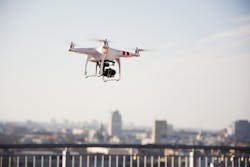Security, video surveillance to play a key role in commercial drone applications
According to a new report from Tractica, the interest by businesses in using drones for various applications is expected to drive shipments of commercial-grade unmanned aerial vehicles (UAVs) from 80,000 in 2015 to more than 2.6 million units annually by 2025. The research firm predicts that annual revenue from commercial drone hardware sales will reach nearly $4 billion within the same timeframe.
However, Tractica said the more significant revenue opportunity will be in commercial drone-enabled services, such as mapping, aerial mapping and disaster relief, which is expected to grow to $8.7 billion annually by 2025. Of course, security and video surveillance applications are expected to be one of the drivers for the adoption of drone technology in the coming years. Here is a commentary from Tractica analysts Bob Lockhart and Chad Mitchell on the role security and video surveillance applications are expected to have on the market for drones.
As regulations are passed and technology matures, Tractica expects companies across many vertical markets to employ drone-enabled surveillance and security systems. Increased demand, especially from organizations with large, remote infrastructures, will be instrumental in driving growth. Price drops and technological improvements such as more powerful and lighter weight batteries, autonomous navigation, and security will make drones for surveillance desirable to an increasingly diverse audience of companies and nations. For example, a semi-autonomous drone equipped with 4K video and ultrasound-based navigation technology now costs less than $1,300.
Miniaturization and the proliferation of nascent sensor technology will provide drones with a growing number of capabilities such as nighttime surveillance, biometrics-based facial and behavior recognition, and motion sensing. These technologies, paired with centralized identity databases, will soon enable inexpensive and scalable drone-enabled mass surveillance systems with automated identification of high-risk individuals and groups. It is important to note that drone-based surveillance systems will likely not replace existing systems, but rather will be complementary to and integrated with them.
Barriers to adoption nonetheless remain. Drone-enabled surveillance systems have yet to be tested and validated at scale. How robust are these systems to component failure? What blind spots exist in surveillance coverage? Is periodic surveillance needed or persistent surveillance? How much redundancy is needed to maintain surveillance integrity if drones malfunction or are attacked?
Cybersecurity is another open issue. Drones will be accessing and collecting sensitive information, making them attractive targets for hackers and concerned citizens. Even if data can be secured, other security features can be exploited. For example, communication signals or GPS signals can be jammed (denial of service attacks), preventing critical navigation and analysis tasks from being executed. Real-time data transmission from drones should at least be encrypted and if possible redundant.
Drones are small and by their nature deployed in environments of low physical security. Any organization using drones should assume that some will be stolen or otherwise compromised, removing them from service and putting them into the hands of criminals or competitors. Before drones are put into service, the organization should define incident response and business continuity plans for these situations. The plans must especially consider intellectual property and personally identifiable information (PII) on board the drone.
Depending upon how they are integrated into an enterprise, drones can potentially affect the status of current audit certifications such as Sarbanes-Oxley in the U.S. and PII protection in many jurisdictions. The ongoing operational budget for drones should include collecting, storing, and producing evidence of regulatory compliance wherever applicable.
Additionally, regulatory hurdles are impeding progress. The FAA is still lagging behind in implementing commercial drone legislation despite large increases in lobbying by pro-drone groups. In the U.S., however, property owners utilizing drones for security and surveillance for their own private use is allowed as long as U.S. civil airspace is not breached. Comparatively, in some other countries drone laws are more relaxed. Latin America alone has 14 countries with drone-enabled surveillance programs.
Public privacy and civil liberties concerns also need to be addressed. In 2014, the Inter-American Commission on Human Rights took issue with the deployment of drones in 14 countries. As drone technology becomes more widely used, privacy concerns will undoubtedly rise. Nonetheless, the vast majority of surveillance and security applications will not be an issue. For example, monitoring poachers and agricultural crops are typically viewed as beneficial. Additionally, monitoring large industrial parks and critical infrastructure will not be a great cause for concern for most citizens.
For more information or to download a free executives summary of the report, “Drones for Commercial Applications,” visit www.tractica.com.
